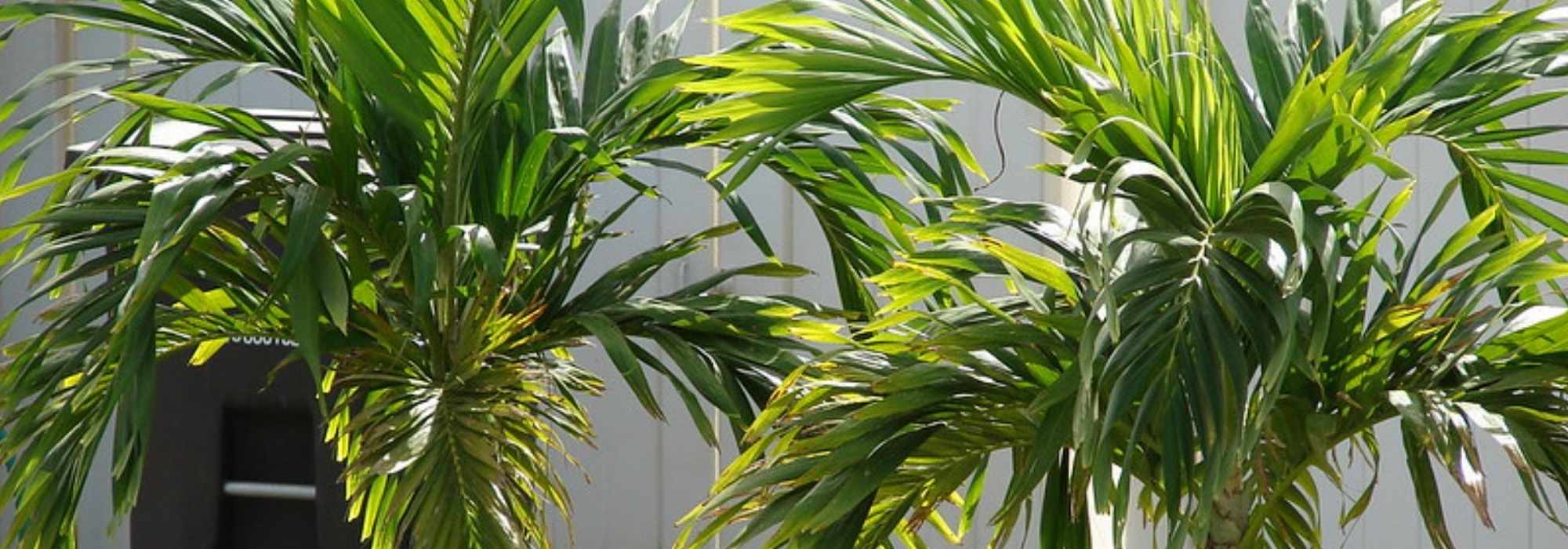
Veitchia (Adonidia): planting, growing, and care
Contents
Veitchia in a nutshell
- This is a stunning small tropical palm, perfect for indoors, a greenhouse, or a conservatory.
- It is remarkable for its large clusters of bright red seeds at Christmas.
- Very sensitive to cold, it should be grown in containers or large pots to protect it from winter frost.
- It boasts an elegant silhouette with its large, gracefully incurved fronds.
- Slow-growing, it does not exceed 2 metres in any direction.
The word from our expert
The Veitchia is a stunning tropical humid climate palm tree that captivates with its elegant silhouette, much like the Adonidia merrillii, one of the most decorative in the genus! The latter is particularly attractive when it produces its red fruits, which ripen at the end of the year, earning it the nickname “Christmas palm.” Very sensitive to cold, its only drawback is its hardiness; it cannot tolerate frost, making outdoor cultivation in our country unfeasible. It can, however, be grown in a pot, allowing it to be sheltered from the cold in winter.
It makes a beautiful indoor palm tree, as it does not exceed 2m in height, and adapts perfectly to cultivation in a very large container or a large pot. It can be placed on the terrace or balcony from May to September.
Discover this magnificent indoor palm tree!
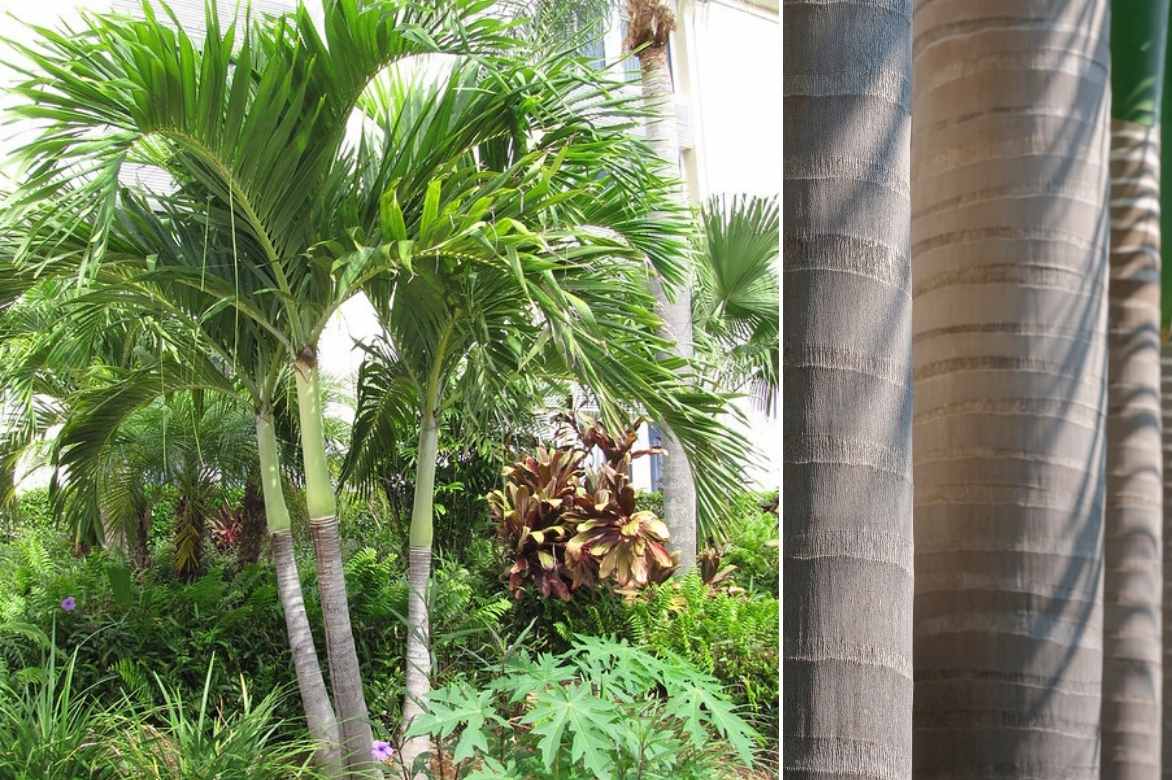
Veitchia merrillii, habit and on the right, a close-up of the trunk
Description and Botany
Botanical data
- Latin name Veitchia, Adonidia
- Family Arecaceae
- Common name Manila palm, Christmas palm
- Flowering summer
- Height 1-2 m
- Exposure Sun, partial shade
- Soil type Rich, moist, well-drained
- Hardiness Frost-sensitive
The Veitchia is a palm tree belonging to the large Arecaceae family, which includes thousands of species, distributed across 185 different genera. The Veitchia genus comprises around ten species native to the humid tropical forests of tropical Asia, particularly the Philippines, Malaysia, Borneo, and Oceania. Among them are Veitchia arecina, Veitchia filifera, and the Adonidia merrillii, formerly known as Veitchia merrillii, more commonly called the Manila palm or, even more so, the Christmas palm. It is also nicknamed the “Paul and Virginie palm” in reference to the children who grew up in harmony with nature and the natural splendour of tropical landscapes. The Veitchia merrillii has even naturalised in the Antilles. It is now classified in the Adonidia genus, of which it is currently the sole representative and the only one cultivated in our latitudes.
From its tropical origins, it retains a very frost-sensitive temperament that does not tolerate our winters. This is why planting it directly in the ground in our gardens is not feasible. It requires warmth, light, and a humid atmosphere to thrive. In our climates, it is grown in containers or large pots to be placed on the terrace in summer and sheltered from frost in winter: it makes a very beautiful indoor palm tree.
In the wild, under tropical conditions, the Adonidia merrillii can reach over 4.50 m in height, but in a pot, it will not exceed 2 m in any direction.
This is a single-stemmed palm tree characterised by a solitary stipe or false trunk. It slowly develops a long, very straight, slender, smooth, grey stipe, strongly ringed with prominent foliar scars. These rings represent the remnants of old petioles that have detached. The stipe is equipped with a green foliar sheath. At the top of the stipe, a cluster of large fern-like leaves unfolds. The foliar crown consists of 12 to 15 large, beautiful, evergreen, and arched fronds. Each leaf is divided into 40 to 62 lanceolate leaflets arranged regularly along the central vein. They measure up to 2 m long and are gracefully curved towards the ground. Each is attached to the stipe by a short, glabrous petiole.
The foliage is an intense green, though it can sometimes take on slightly greyish hues.
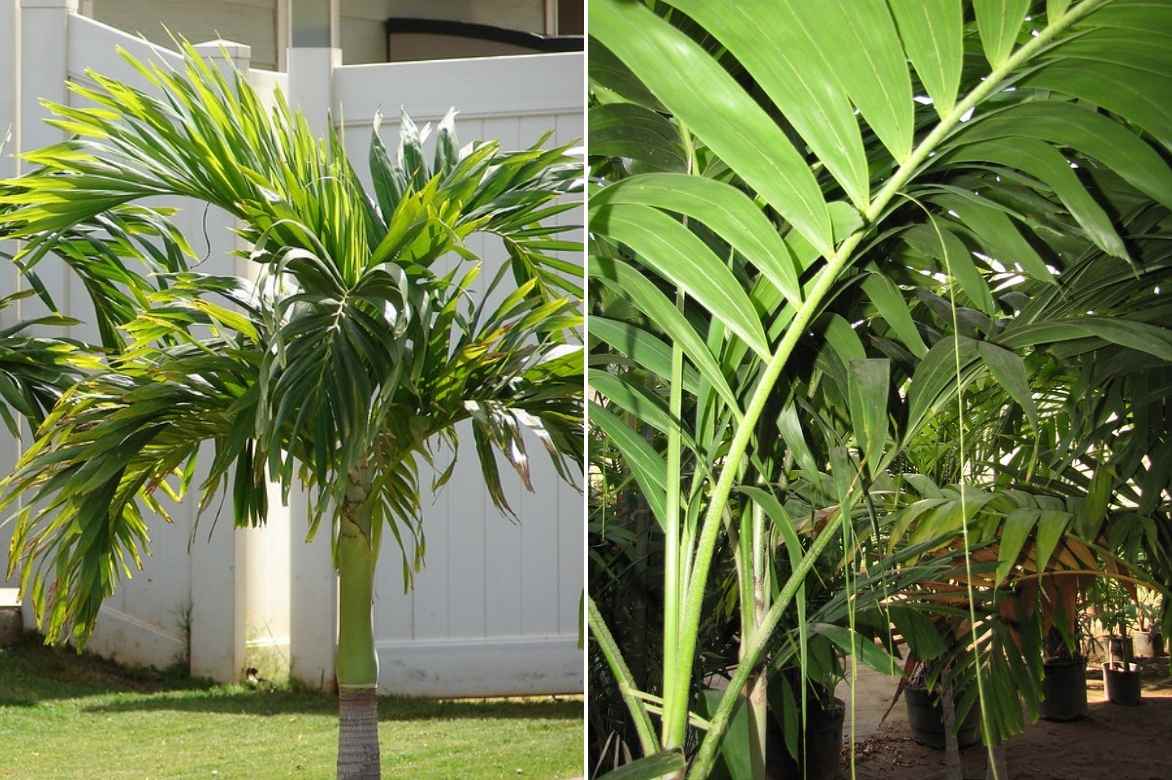
Veitchia merrillii and Veitchia joannis (© Forest and Kim Starr)
Flowering occurs in summer, on mature specimens, after 10 to 11 years, and under favourable growing conditions. The Veitchia merrillii, for example, is a monoecious species, meaning male and female flowers coexist on the same plant. The unisexual flowers, grouped in panicles beneath the foliar crown, appear in the axils of the leaves. They take the form of arched, branched white inflorescences 40-50 cm long. They reveal numerous stamens with white filaments. English speakers commonly call it the “Christmas Palm” because it is during this time of year that the tree bears fruit. After fertilisation by insects, the female flowers produce ovoid fruits 1 to 2 cm long. These drupes, equipped with a beak, ripen at the end of the year, displaying a bright red colour, very decorative in winter. They contain a single seed.
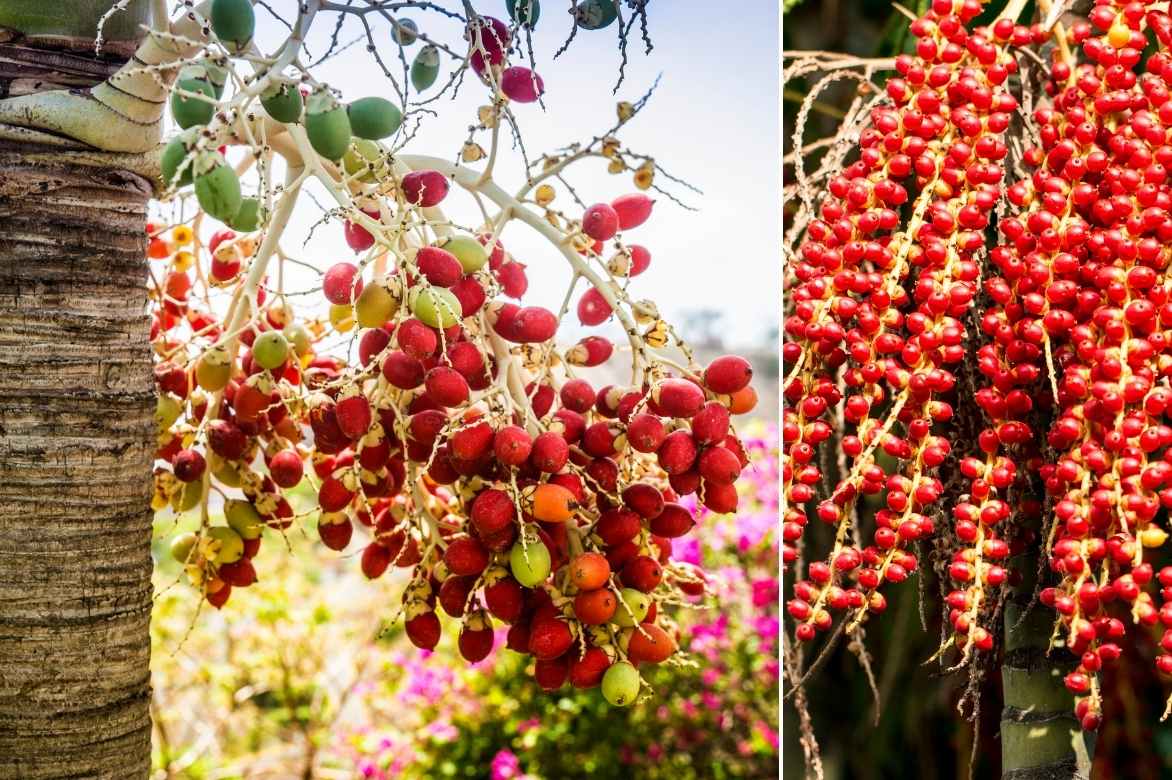
Fruits of Veitchia merrillii
Main species and varieties
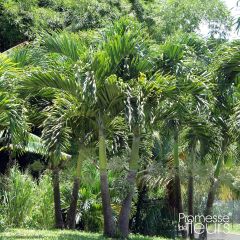
Veitchia merrillii - Manila Palm
- Flowering time August, September
- Height at maturity 4,50 m
Discover other Veitchia
View all →Available in 1 sizes
Available in 1 sizes
Available in 1 sizes
Planting the Christmas Palm Tree
Where to Plant It?
The Christmas palm cannot tolerate freezing temperatures. It dies below 0°C. It is commonly found in tropical regions or in mild climates like Florida, where it thrives. This is why it cannot be acclimatised to our gardens. It should be grown in a very large pot so it can be overwintered away from frost. It makes an excellent houseplant, as it can easily be grown indoors year-round. Its slow growth allows it to remain in a pot without issue for many years.
It will make a striking addition to a conservatory, greenhouse, or a very bright, minimally heated room where temperatures range between 10 and 15°C. Avoid placing the pot behind a window or glass door: opt for a bright, filtered spot, sheltered from harsh sunlight. This tropical plant thrives in warm, humid environments. During the warmer months, as soon as outdoor temperatures allow, you can move it to the terrace or balcony from May to September. It will enjoy the summer rains and sunshine. In a pot, it will look stunning near a pool, adding an exotic touch to any setting.
When to Plant the Christmas Palm?
We recommend planting your palm in spring, between April and June.
How to Plant It?
The Manila palm grows very well in a pot, which can be placed on the terrace in summer and brought indoors to shelter from frost in winter. The substrate must be well-draining. It is often planted in groups of three in the same pot.
- Choose a large pot or container with drainage holes, with a capacity of 40 litres.
- Place a 5 cm layer of drainage material at the bottom (clay pebbles or pumice).
- Partially fill the container with a mix of 25% heather soil, 50% light potting mix for balconies and terraces or humus, and 25% sand.
- Plant your palm without burying the collar.
- Fill in around the root ball with the mix, firming it down well.
- Water generously until the pot is saturated.
Indoors, place the pot away from direct sunlight. If you move it outdoors from May to September, acclimatise it to the sun gradually: start by placing it in partial shade, then slowly introduce it to full sun.
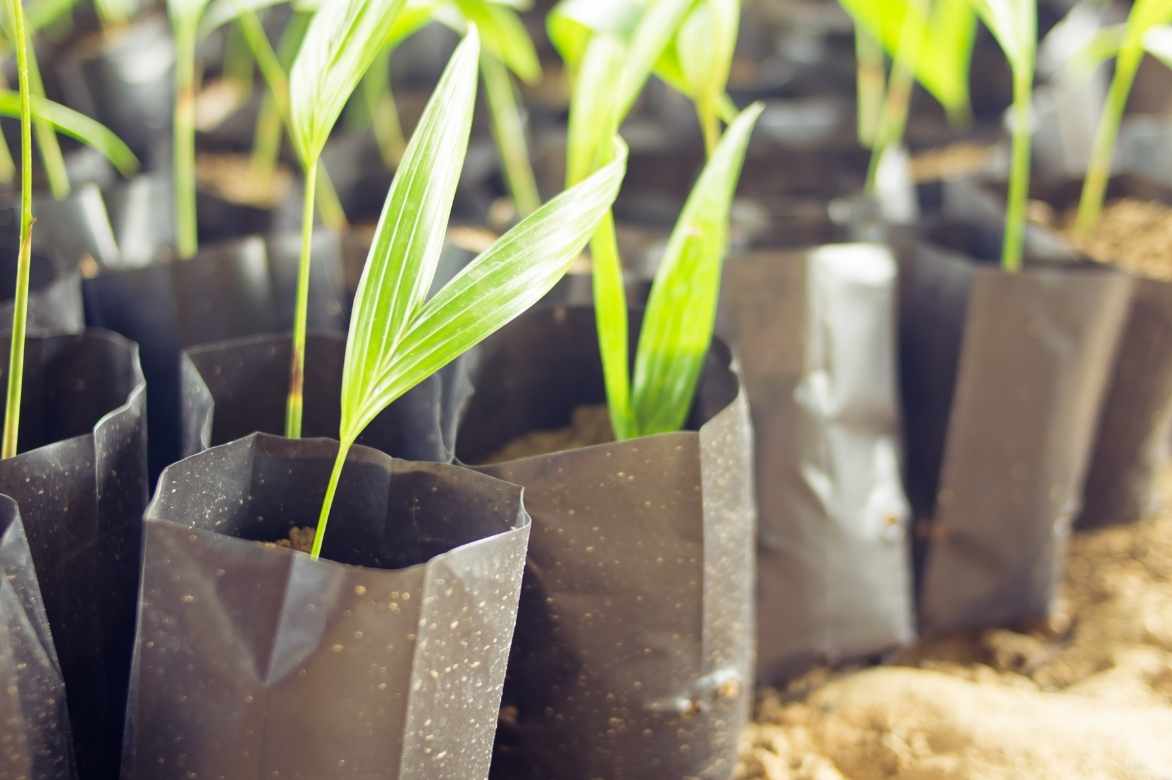
Veitchia merrillii plants
Care for a Potted Christmas Palm Tree
In Summer
The Veitchia merrillii is an easy-to-care-for plant. It requires a light, well-drained, and rich substrate that remains consistently moist from spring to autumn. Water approximately once a week during the growth period, but avoid waterlogging the soil to prevent the roots from rotting.
From May to August, to maintain beautiful, vibrant green fronds, apply a special palm fertiliser to the watering water once a month.
In Winter
From autumn onwards, as soon as nighttime temperatures drop to 10°C, bring your palm indoors or into a greenhouse, ideally at 10-15°C. Place it in a well-lit location but away from direct sunlight. Reduce watering to once every two weeks, allowing the substrate to dry slightly between waterings. Stop fertilising. Veitchia palms dislike dry air: mist the foliage regularly to maintain humidity and take the opportunity to remove dust with a sponge. This step is crucial for palms grown indoors, as indoor air is much drier than outdoor air.
Repot every 2-3 years in spring into a slightly larger container to completely renew the substrate. Take this opportunity to fertilise by adding some crushed horn. Alternatively, you can simply top-dress annually by adding a 4 cm layer of compost or fresh potting mix.
Indoors, this palm may be attacked by mealybugs, which leave small white cottony clusters on the leaves and can disrupt its healthy growth: remove them with a cotton pad soaked in 90°C alcohol and regularly spray with a greasy rapeseed oil mixture to suffocate them (1 litre of warm water + 1 tablespoon of oil + 1 drop of washing-up liquid).
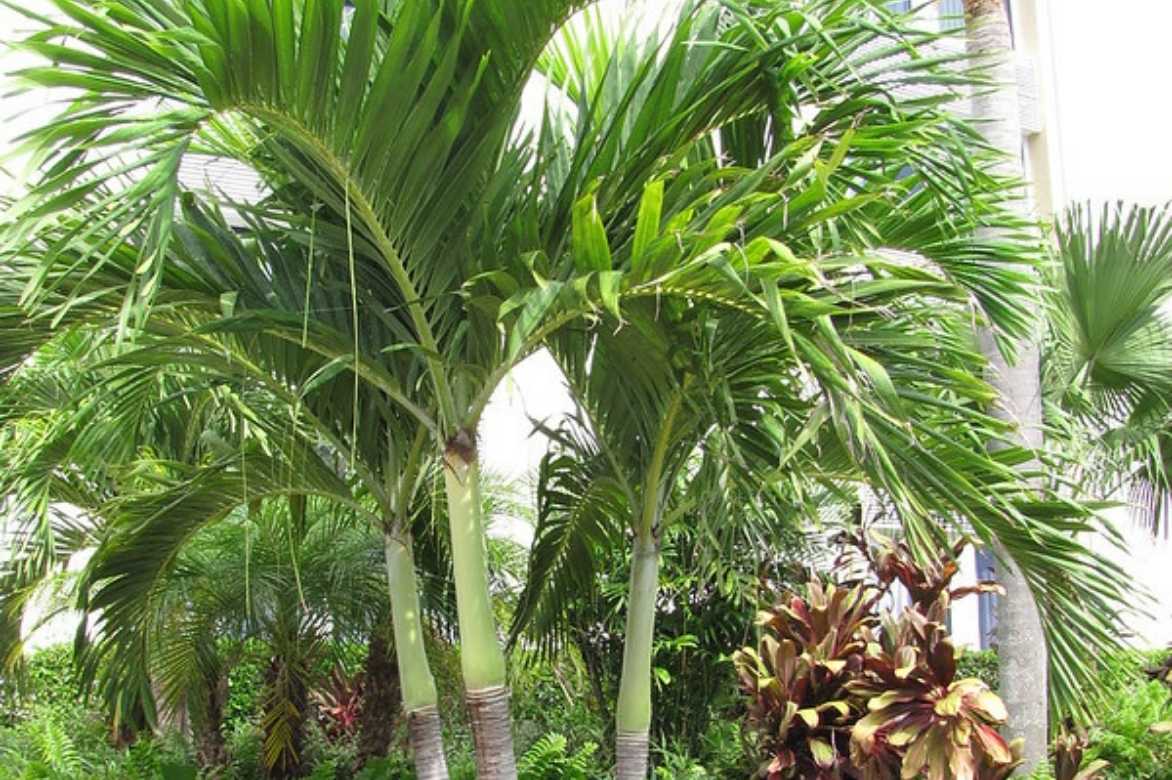
Veitchia merrillii © Forest and Kim Starr
How to grow a Christmas palm shoot?
The Adonidia merrillii can only be propagated by sowing, but this process takes time. If the seeds take 90 to 120 days to germinate, you will need to wait 3 or 4 years to obtain a viable and robust young plant. After cold stratification in the fridge, sow the seeds in a mixture of 50% seed compost and 50% sand. Keep the substrate moist but not waterlogged. Place in a heated greenhouse at 20 to 25°C without direct sunlight. Water with a fine spray. After 3 months, transplant the young plants into pots filled with compost. Water regularly. Gradually acclimatise them to sunlight during the warmer season.
Associate
With its very elegant habit, the Adonidia merrillii often stands well on its own due to its strong personality.
In a pot on a terrace, for an exotic setting, or in a contemporary garden, it pairs beautifully with Phormiums, Yuccas, Agaves, and Cordylines, plants with remarkable graphic appeal and an equally exotic allure.
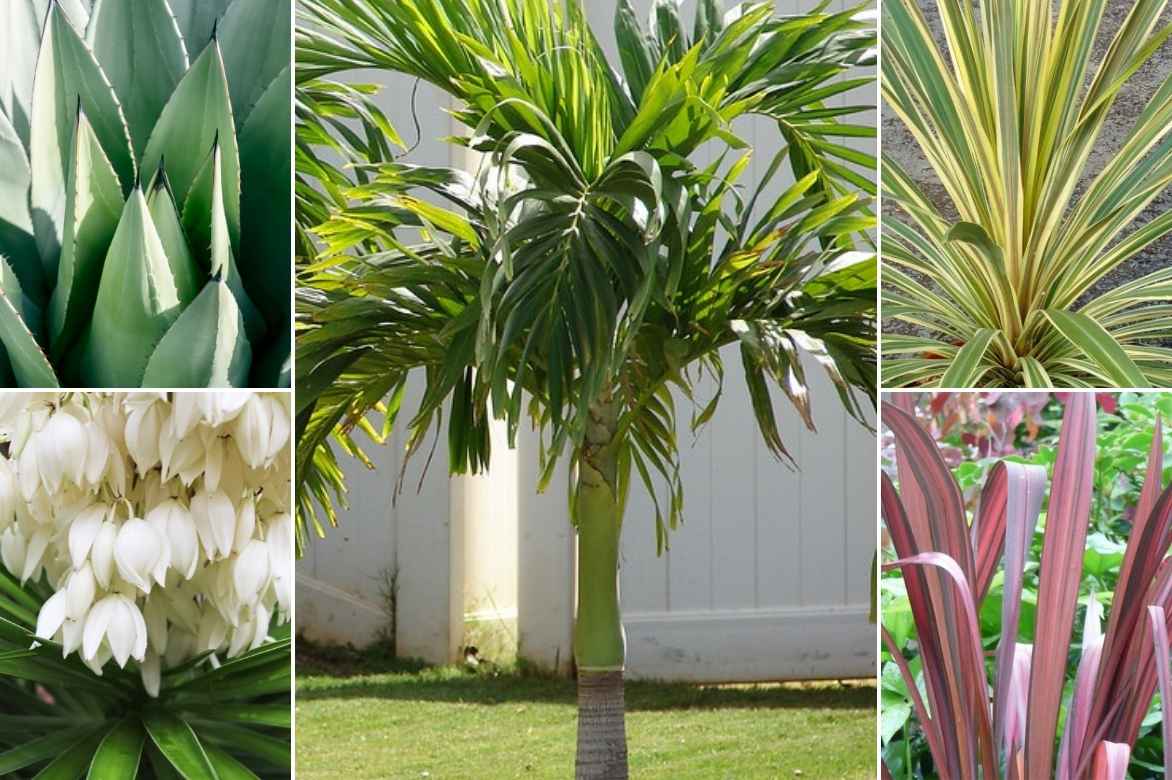
Veitchia alongside an Agave parryi, a Yucca, a Cordyline ‘Torbay Dazzler’, and a Phormium tenax ‘Evening Glow’
Useful resources
- Our range of palm trees!
- How to create an exotic garden?
- Our advice sheet: Palm trees by climate
- Subscribe!
- Contents
































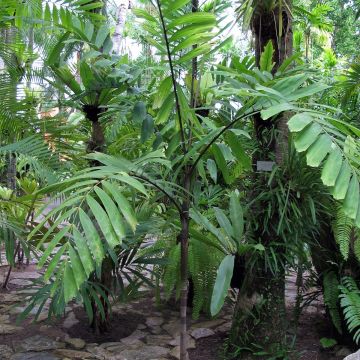
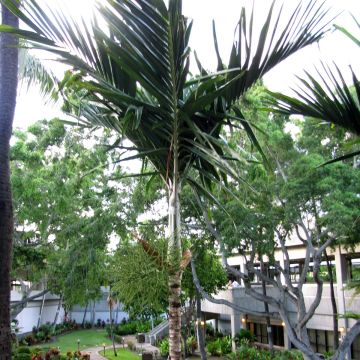
Comments